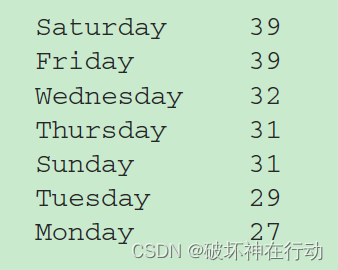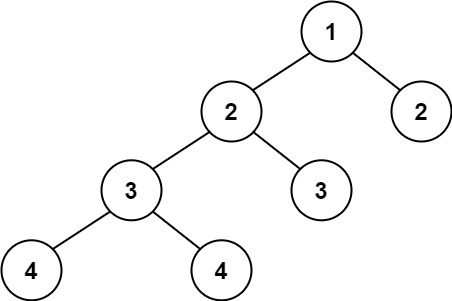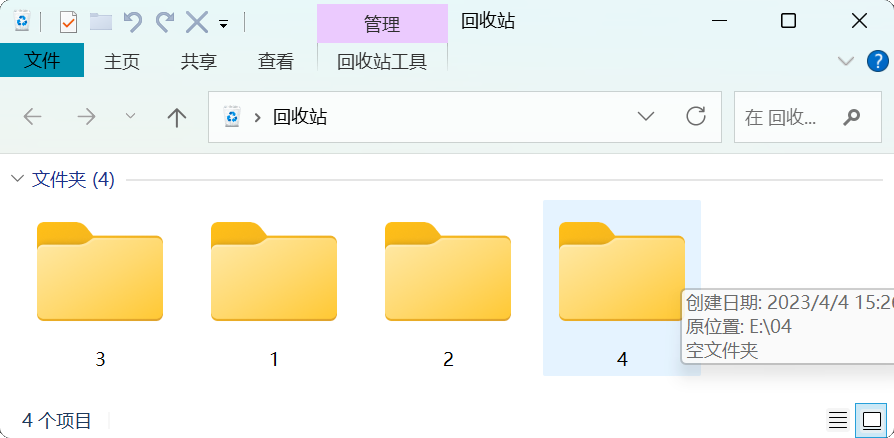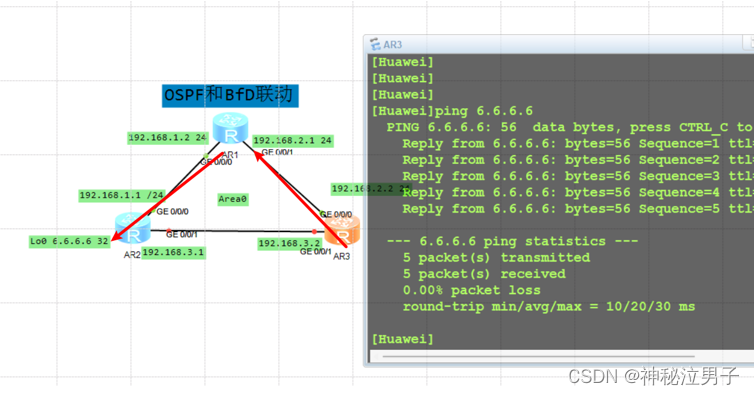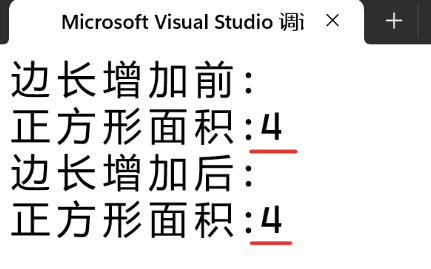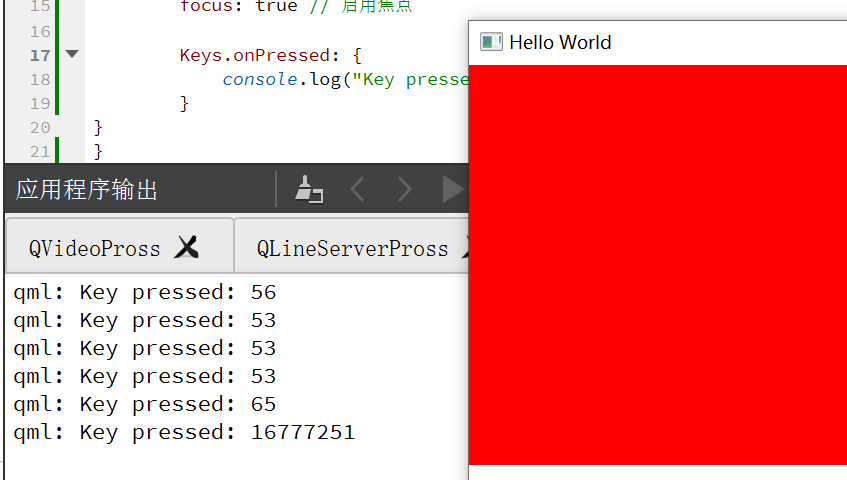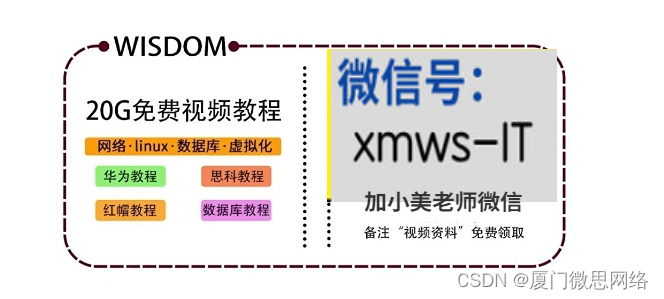系列文章
- EasyExcel生成带下拉列表或多级级联列表的Excel模版+自定义校验导入数据(修订)
目录
- 系列文章
- 前言
- 仓库
- 一、实现
- 1.1 下拉元数据对象
- 1.2 构建下拉元数据的映射关系
- 1.3 框架方式
- 1.3.1 框架实现
- 1.3.2 框架用例
- 模版类
- 加载下拉业务
- 导出接口
- 1.4 EasyExcel方式
- 1.4.1 EasyExcel用例
- 导出接口
- 二、效果
- 2.1 下拉sheet
- 2.2 业务sheet
- 附录
- SpELHelper
前言
有同好提过这问题, 有一定的使用场景, 最近设计了一下并落地了, 支持直接使用框架方式或直接使用EasyExcel方式.
该迭代仅限使用SpEL能力最新版本代码, 历史版本忽略.
仓库
仓库: excel-common-spring-boot-starter (请参考最新代码, 文档内容更新不会很勤快, 没License看得上就随便用)
一、实现
核心逻辑: 创建下拉元数据对象时需要通过解析SpEL表达式获取下拉数据, 该能力提供的上下文对象EvaluationContext支持传入自定义参数, 并可以根据表达式指定的参数名从上下文中获取到指定参数并传给指定的调用方法.
调用方式: 使用框架和直接使用EasyExcel的两种方式, 在传入动态参数的方式上有所不同, 用例 部分会通过代码说明.
例如: SpEL表达式为 @xxxBean.findAllByTypeAndCode(#type, #code)
- @开头指定选择SpringBean的名称
- .findAllByTypeAndCode指定调用该bean的方法
- #type指定从表达式上下文中解析名为 type 和 code 的 变量, 并传入findAllByTypeAndCode()方法.
1.1 下拉元数据对象
解析表达式时, 通过Visitor将参数设置到上下文中.
- SpELHelper 见 附录 部分
/**
* @author hp
*/
@Slf4j
@Getter
@Setter
public abstract class AbstractExcelSelectModel<T> {
protected int headLayerCount;
protected T options;
protected String columnName;
protected int columnIndex;
protected String parentColumnName;
protected int parentColumnIndex;
protected int firstRow;
protected int lastRow;
public AbstractExcelSelectModel(@Nonnull Field field, @Nonnull ExcelSelect excelSelect, @Nullable ExcelProperty excelProperty, int defaultSort, @Nullable Map<String, Object> parameters) {
final Optional<ExcelProperty> excelPropertyOpt = Optional.ofNullable(excelProperty);
this.headLayerCount = excelPropertyOpt.map(property -> property.value().length).orElse(1);
this.firstRow = Math.max(excelSelect.firstRow(), this.headLayerCount);
this.lastRow = excelSelect.lastRow();
this.parentColumnName = excelSelect.parentColumnName();
this.columnName = excelPropertyOpt.map(property -> property.value()[this.headLayerCount - 1]).orElse(field.getName());
this.columnIndex = excelPropertyOpt.map(property -> property.index() > -1 ? property.index() : defaultSort).orElse(defaultSort);
this.options = resolveOptions(excelSelect, parameters);
}
public boolean hasParentColumn() {
return StrUtil.isNotEmpty(this.parentColumnName);
}
@SuppressWarnings("unchecked")
@Nullable
protected T resolveOptions(@Nonnull ExcelSelect excelSelect, @Nullable Map<String, Object> parameters) {
final ExcelOptions excelOptions = excelSelect.options();
if (StrUtil.isEmpty(excelOptions.expression())) {
log.warn("The ExcelSelect on {} has no options whatsoever.", this.columnName);
return null;
}
final SpELHelper spELHelper = SpringUtil.getBean(SpELHelper.class);
return (T) spELHelper.newGetterInstance(excelOptions.expression()).apply(
null,
// 在这里向上下文中设置自定义变量.
(evaluationContext -> Optional.ofNullable(parameters).ifPresent(map -> map.forEach(evaluationContext::setVariable)))
);
}
}
1.2 构建下拉元数据的映射关系
Convention: @Nullable Map<String, Object> parameters 参数定义为Map集合类型
提交动态数据的入口, 同时根据实际列注解情况构建下拉元数据的映射关系
/**
* @author hp
*/
@Slf4j
@UtilityClass
public class ExcelSelectHelper {
@Nullable
public static <T> Map<Integer, ? extends AbstractExcelSelectModel<?>> createSelectionMapping(@Nonnull Class<T> dataClass) {
return createSelectionMapping(dataClass, null);
}
@Nullable
public static <T> Map<Integer, ? extends AbstractExcelSelectModel<?>> createSelectionMapping(@Nonnull Class<T> dataClass, @Nullable Map<String, Object> parameters) {
final Field[] fields = ReflectUtil.getFields(dataClass);
final AtomicInteger fieldIndex = new AtomicInteger(0);
final Map<Integer, ? extends AbstractExcelSelectModel<?>> selectionMapping = Arrays.stream(fields)
.map(field -> {
final ExcelSelect excelSelect = AnnotatedElementUtils.getMergedAnnotation(field, ExcelSelect.class);
if (Objects.isNull(excelSelect)) {
log.debug("No ExcelSelect annotated on {}, skip processing", field.getName());
fieldIndex.getAndIncrement();
return null;
}
final ExcelProperty excelProperty = AnnotatedElementUtils.getMergedAnnotation(field, ExcelProperty.class);
AbstractExcelSelectModel<?> excelSelectModel;
if (StrUtil.isNotEmpty(excelSelect.parentColumnName())) {
excelSelectModel = new ExcelCascadeModel(field, excelSelect, excelProperty, fieldIndex.getAndIncrement(), parameters);
} else {
excelSelectModel = new ExcelSelectModel(field, excelSelect, excelProperty, fieldIndex.getAndIncrement(), parameters);
}
return excelSelectModel;
})
.filter(Objects::nonNull)
.collect(Collectors.toMap(AbstractExcelSelectModel::getColumnIndex, Function.identity(), (a, b) -> a));
if (MapUtil.isEmpty(selectionMapping)) {
return null;
}
// 设置父列索引
final Map<String, Integer> columnNamedMapping = selectionMapping.values()
.stream()
.collect(Collectors.toMap(AbstractExcelSelectModel::getColumnName, AbstractExcelSelectModel::getColumnIndex));
selectionMapping.forEach((k, v) -> {
if (v.hasParentColumn() && columnNamedMapping.containsKey(v.getParentColumnName())) {
v.setParentColumnIndex(columnNamedMapping.get(v.getParentColumnName()));
}
});
return selectionMapping;
}
}
1.3 框架方式
框架方式基于SpringAOP能力, 纯静态配置方式导出模版或数据, 所以无法通过人为调用的方式提交动态参数.
1.3.1 框架实现
同动态指定导出文件名称的方式相同, 在导出时, 通过向HttpServletRequest对象中设置指定Key(ExcelConstants.DROPDOWN_QUERY_PARAMS_ATTRIBUTE_KEY)的Attributes, 根据约定, 框架将通过该指定Key查询是否存在参数, 有则使用.
框架通过Enhance类配置ExcelWriterBuilder和ExcelWriterSheetBuilder, 并且框架考虑自动导出多sheet情况, 所以在enhanceExcel()中获取动态参数并处理.
/**
* @author hp
*/
@Slf4j
public class ExcelSelectExcelWriterBuilderEnhance implements ExcelWriterBuilderEnhance {
protected final AtomicInteger selectionColumnIndex = new AtomicInteger(0);
protected Map<Class<?>, Map<Integer, ? extends AbstractExcelSelectModel<?>>> selectionMapMapping = Maps.newHashMap();
@SuppressWarnings("unchecked")
@Override
public ExcelWriterBuilder enhanceExcel(
ExcelWriterBuilder writerBuilder,
ResponseExcel responseExcel,
Collection<? extends Class<?>> dataClasses,
HttpServletRequest request,
HttpServletResponse response
) {
final Object attribute = Objects.requireNonNull(request).getAttribute(ExcelConstants.DROPDOWN_QUERY_PARAMS_ATTRIBUTE_KEY);
final Map<String, Object> parameters = Optional.ofNullable(attribute)
.map(attr -> {
Preconditions.checkArgument(attr instanceof Map<?, ?>);
return (Map<String, Object>) attribute;
}).orElse(null);
dataClasses.forEach(dataClass -> selectionMapMapping.put(dataClass, ExcelSelectHelper.createSelectionMapping(dataClass, parameters)));
return writerBuilder.registerWriteHandler(new SelectDataWorkbookWriteHandler());
}
@Override
public ExcelWriterSheetBuilder enhanceSheet(
ExcelWriterSheetBuilder writerSheetBuilder,
Integer sheetNo,
String sheetName,
Class<?> dataClass,
Class<? extends HeadGenerator> headEnhancerClass,
String templatePath) {
if (selectionMapMapping.containsKey(dataClass)) {
final Map<Integer, ? extends AbstractExcelSelectModel<?>> selectionMapping = selectionMapMapping.get(dataClass);
writerSheetBuilder.registerWriteHandler(new SelectDataSheetWriteHandler(selectionColumnIndex, selectionMapping));
}
return writerSheetBuilder;
}
}
1.3.2 框架用例
模版类
/**
* @author hp
*/
@EqualsAndHashCode(callSuper = true)
@Data
public class DynamicParametersExcelTemplate extends ExcelTemplate {
@ExcelSelect(
options = @ExcelOptions(expression = "@excelSelectDynamicDataHandler.findAll()")
)
@ExcelProperty("动态单列下拉列表")
private LocalDate dynamicSelectColumn;
@ExcelProperty("非下拉列No3")
private String noneDropdownNo3;
@ExcelSelect(
options = @ExcelOptions(expression = "@excelSelectDynamicParameterDataHandler.findAllForParentByType(#type)")
)
@ExcelProperty("动态参数父列")
private Integer dynamicParameterParentColumn;
@ExcelProperty("非下拉列No1")
private String noneDropdownNo1;
@ExcelProperty("非下拉列No2")
private String noneDropdownNo2;
@ExcelSelect(
parentColumnName = "动态参数父列",
options = @ExcelOptions(expression = "@excelSelectDynamicParameterDataHandler.findAllForChildrenByValueGt(#value)")
)
@ExcelProperty("动态参数子列")
private Integer dynamicParameterChildColumn;
}
加载下拉业务
/**
* @author hp
*/
@Component
public class ExcelSelectDynamicParameterDataHandler {
public List<String> findAllForParentByType(String type) {
final Map<String, List<String>> map = Maps.newHashMap();
map.put("TYPE-A", List.of("1", "2", "3", "4"));
map.put("TYPE-B", List.of("一", "二", "三", "四"));
return map.getOrDefault(type, Collections.emptyList());
}
public Map<String, List<Integer>> findAllForChildrenByValueGt(Integer limitation) {
final Map<String, List<Integer>> map = Maps.newHashMap();
map.put("1", Stream.of(10, 20, 30, 40, 50, 60).filter(i-> i> limitation).toList());
map.put("2", Stream.of(30, 40, 50, 60, 70, 80, 90).filter(i-> i> limitation).toList());
return map;
}
}
导出接口
@ResponseExcel(
name = "DynamicParametersExcelTemplate",
sheets = {
@Sheet(sheetName = "sheet", sheetNo = 0),
},
enhancement = {ExcelSelectExcelWriterBuilderEnhance.class}
)
@PostMapping("template/sheet/single/DynamicParametersExcelTemplate")
public List<DynamicParametersExcelTemplate> singleSheet5(HttpServletRequest request) {
final Map<String, Object> map = Maps.newHashMap();
map.put("type","TYPE-A");
map.put("value",40);
request.setAttribute(ExcelConstants.DROPDOWN_QUERY_PARAMS_ATTRIBUTE_KEY, map);
return Collections.singletonList(new DynamicParametersExcelTemplate());
}
1.4 EasyExcel方式
原生方式相当于很多框架做的配置工作都给人来完成, 那自然很容易拿到提交动态参数的入口, 可以直接提交参数.
1.4.1 EasyExcel用例
导出接口
在设置handler时, 直接将下拉元数据映射提交给 SelectDataSheetWriteHandler 即可, 此时可以提交动态参数, 用例里偷懒写了null.
new SelectDataSheetWriteHandler(index, ExcelSelectHelper.createSelectionMapping(MultipleSheetNo1ExcelTemplate.class, null))
@PostMapping("/easyexcel/template")
public void template(HttpServletRequest request, HttpServletResponse response) {
String filename = "文件名称";
final AtomicInteger index = new AtomicInteger(0);
String userAgent = request.getHeader("User-Agent");
if (userAgent.contains("MSIE") || userAgent.contains("Trident")) {
// 针对IE或者以IE为内核的浏览器:
filename = java.net.URLEncoder.encode(filename, StandardCharsets.UTF_8);
} else {
// 非IE浏览器的处理:
filename = new String(filename.getBytes(StandardCharsets.UTF_8), StandardCharsets.ISO_8859_1);
}
response.setContentType("application/vnd.ms-excel");
response.setHeader("Content-disposition", String.format("attachment; filename=\"%s\"", filename + ".xlsx"));
response.setHeader("Cache-Control", "no-cache");
response.setHeader("Pragma", "no-cache");
response.setDateHeader("Expires", -1);
response.setCharacterEncoding("UTF-8");
final ExcelWriterBuilder excelWriterBuilder;
try {
excelWriterBuilder = EasyExcel.write(response.getOutputStream());
} catch (IOException e) {
throw new RuntimeException(e);
}
try (
ExcelWriter excelWriter = excelWriterBuilder
.registerWriteHandler(
new SelectDataWorkbookWriteHandler()
)
.build()
) {
WriteSheet writeSheet = EasyExcel
.writerSheet(0, "sheet名称")
.head(MultipleSheetNo1ExcelTemplate.class)
.registerWriteHandler(new SelectDataSheetWriteHandler(index, ExcelSelectHelper.createSelectionMapping(MultipleSheetNo1ExcelTemplate.class, null)))
.build();
excelWriter.write(new ArrayList<String>(), writeSheet);
WriteSheet writeSheet2 = EasyExcel
.writerSheet(1, "sheet名称2")
.head(MultipleSheetNo2ExcelTemplate.class)
.registerWriteHandler(new SelectDataSheetWriteHandler(index, ExcelSelectHelper.createSelectionMapping(MultipleSheetNo2ExcelTemplate.class, null)))
.build();
excelWriter.write(new ArrayList<String>(), writeSheet2);
excelWriter.finish();
} catch (Exception e) {
log.error("导出Excel文件异常", e);
}
}
二、效果
2.1 下拉sheet
可见根据框架用例的条件和查询方法, TYPE-A 类型的数据和 大于40的数据被用于创建下拉选项
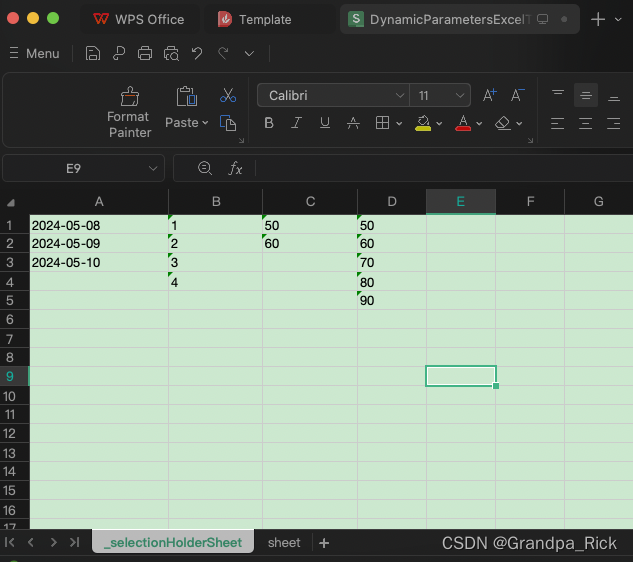
2.2 业务sheet
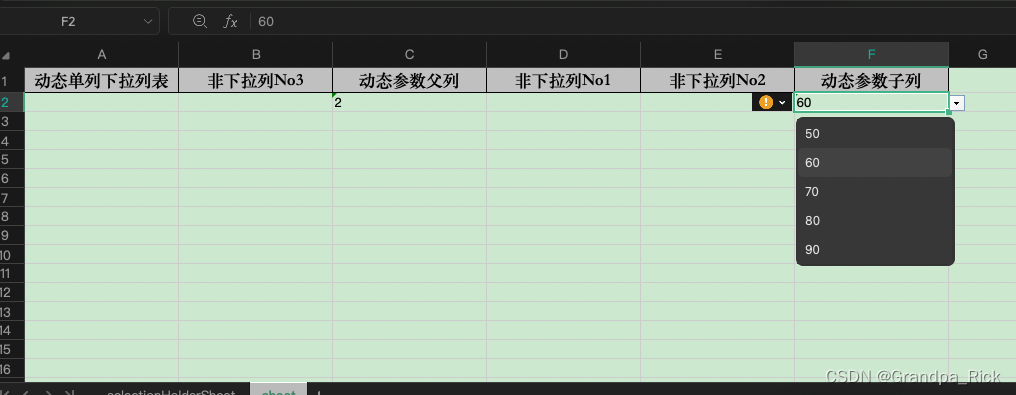
附录
SpELHelper
package com.luban.common.base.utils;
import cn.hutool.core.util.StrUtil;
import com.luban.common.base.visitor.Visitor;
import lombok.extern.slf4j.Slf4j;
import org.springframework.beans.BeansException;
import org.springframework.context.ApplicationContext;
import org.springframework.context.ApplicationContextAware;
import org.springframework.context.annotation.Configuration;
import org.springframework.context.expression.BeanFactoryResolver;
import org.springframework.expression.*;
import org.springframework.expression.spel.standard.SpelExpressionParser;
import org.springframework.expression.spel.support.StandardEvaluationContext;
import org.springframework.lang.NonNull;
import java.lang.reflect.Field;
import java.util.Collection;
import java.util.Objects;
import java.util.Optional;
import java.util.function.BiConsumer;
import java.util.function.BiFunction;
/**
* 很多判断是Groovy语法
* <p>
* Tips:
* <ul>
* <li>字符串单引号. 可以调用方法或访问属性</li>
* <li>属性首字母大小写不敏感</li>
* <li>集合元素: Map用 {@code map['key']} 获取元素, Array/List用 {@code 集合名称[index]} 获取元素</li>
* <li>定义List: {@code {1,2,3,4} 或 {{'a','b'},{'x','y'}} }</li>
* <li>instance of: {@code 'xyz' instanceof T(int)}</li>
* <li>正则: {@code '字符串' matches '正则表达式'}</li>
* <li>逻辑运算符: {@code !非 and与 or或}</li>
* <li>类型: {@code java.lang包下直接用, 其他的要用T(全类名)}</li>
* <li>构造器: {@code new 全类名(构造参数)}</li>
* <li>变量: StandardEvaluationContext当中的变量 {@code #变量名称 }</li>
* <li>#this: 当前解析的对象</li>
* <li>#root: 上下文的根对象</li>
* <li>Spring Bean引用: {@code @beanName} </li>
* <li>三元表达式和Java一样</li>
* <li>Elvis Operator: {@code Names?:'Unknown'} Names为空提供默认值</li>
* <li>防NPE操作符: {@code PlaceOfBirth?.City} 如果为NULL 防止出现NPE</li>
* <li>筛选集合元素: {@code 集合.?[筛选条件]} 如果是Map集合,Map.Entry为当前判断对象</li>
* <li>筛选第一个满足集合元素: {@code 集合.^[筛选条件]}</li>
* <li>筛选第一个满足集合元素: {@code 集合.$[筛选条件]}</li>
* <li>集合映射,类似StreamAPI的map()再collect(): 使用语法 {@code 集合.![映射规则]}, Map集合类似上述说明</li>
* <li>表达式模版: 默认{@code #{} }, 指定解析模版内部的内容</li>
* </ul>
*
* @author hp
*/
@Slf4j
@Configuration
public class SpELHelper implements ApplicationContextAware {
private BeanResolver beanResolver;
private final ExpressionParser expressionParser = new SpelExpressionParser();
private final ParserContext parserContext = ParserContext.TEMPLATE_EXPRESSION;
public <T, R> StandardSpELGetter<T, R> newGetterInstance(String expression) {
return new StandardSpELGetter<>(expression, new StandardEvaluationContext());
}
public <T, R> StandardSpELSetter<T, R> newSetterInstance(Field field) {
return new StandardSpELSetter<>(field);
}
@Override
public void setApplicationContext(@NonNull ApplicationContext applicationContext) throws BeansException {
this.beanResolver = new BeanFactoryResolver(applicationContext);
}
public class StandardSpELGetter<T, R> implements BiFunction<T, Visitor<EvaluationContext>, R> {
private final Expression expression;
private final EvaluationContext evaluationContext;
private StandardSpELGetter(String expression, EvaluationContext evaluationContext) {
if (StrUtil.isNotEmpty(expression) && expression.startsWith(parserContext.getExpressionPrefix())) {
this.expression = expressionParser.parseExpression(expression, parserContext);
} else {
this.expression = expressionParser.parseExpression(expression);
}
this.evaluationContext = Objects.requireNonNull(evaluationContext);
if (this.evaluationContext instanceof StandardEvaluationContext standardEvaluationContext) {
standardEvaluationContext.setBeanResolver(beanResolver);
}
}
@SuppressWarnings("unchecked")
@Override
public R apply(T data, Visitor<EvaluationContext> visitor) {
Optional.ofNullable(visitor).ifPresent(v -> v.visit(evaluationContext));
return (R) expression.getValue(evaluationContext, data);
}
public R apply(T data) {
return apply(data, Visitor.defaultVisitor());
}
}
public class StandardSpELSetter<T, R> implements BiConsumer<T, Collection<R>> {
private final String fieldName;
private final boolean isCollection;
private final Expression expression;
private StandardSpELSetter(Field field) {
this.fieldName = Objects.requireNonNull(field).getName();
this.expression = expressionParser.parseExpression(fieldName);
this.isCollection = Collection.class.isAssignableFrom(Objects.requireNonNull(field).getType());
}
@Override
public void accept(T data, Collection<R> result) {
if (isCollection) {
this.expression.setValue(data, result);
} else {
int size = result.size();
if (size == 1) {
this.expression.setValue(data, result.stream().findFirst().get());
} else {
log.error("write join result to {} error: Too many results, field is {}, data is {}", data, fieldName, result);
}
}
}
}
}
